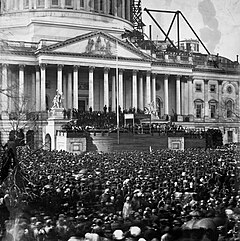to Donald Trump has left a legacy of lies, racism, criminality and treason from his four years in the White House.
But his longest-lasting—and most destructive—legacy revealed itself in the nation’s Capitol.
Every Presidential Inaugural proves a nightmarish challenge for Federal military and law enforcement agencies charged with protecting the next President and Vice President of the United States.

Inauguration of President Barack Obama – January 20, 2009
But that is not the end of their assignment.
Also needing protection are the dignitaries—members of Congress, Supreme Court Justices, invited foreign heads of state—and the crowd of thousands of onlookers attending.
But the January 20 swearing in of Joseph Robinette Biden as President and Kamala Devi Harris as Vice President was like no other in recent American history.
The reason: The outgoing President, Donald J. Trump, had fiercely resisted the peaceful transfer of power from himself to Biden.
On November 3, 2020, 81,255,933 Democratic voters elected former Vice President Biden the 46th President of the United States. Trump, running for a second term, got 74,196,153 votes.
Since then, Trump had:
- Refused to concede;
- Claimed he was the victim of massive vote fraud;
- Ordered his attorneys to file at least 60 lawsuits to overturn the election results;
- Tried to strongarm governors and secretaries of state in contested states to give him the election; and
- Encouraged members of the House and Senate to contest the counting of Electoral College votes.
With all of that failed, Trump played his final card to illegally gain another four years of power: He summoned thousands of his Stormtrumper followers to Washington, D.C. And, on January 6, he ordered them to “fight like hell” and “stop the steal.”
Donald Trump addressing his Stormtrumpers
Tens of thousands of Stormtrumpers attacked and breached the United States Capitol. They easily brushed aside Capitol Police, who made no effort to arrest or shoot them.
Many of the lawmakers’ offices were occupied and vandalized. One Capitol police officer was killed and more than 50 others were injured.
Not until nightfall—hours later—did police finally restore order to the capitol.
That night, members of Congress once again met to count Electoral College votes—and certify Biden as the winner.
Nevertheless, Trump still refuses to concede and even attend the inauguration of his successor—something that every outgoing President has done with one exception.
In 1869, outgoing President Andrew Johnson refused to attend the inaugural ceremonies, as President-elect Ulysses S. Grant had refused to sit with him in the carriage going to it.
Early on the morning of January 20, Trump took Air Force One to his Mar-a-Lago resort in Palm Beach, Florida. He didn’t intend to meet with Biden or ask him for use of Air Force One to reach Mar-a-Lago.
As a result of the January 6 assault on the Capitol Building, Federal law enforcement braced for the worst.
Before that assault, plans had called for 10,000 National Guard troops to protect the Inaugural celebration. Now 25,000 were being deployed—more troops in Washington than in Iraq and Afghanistan. Their gear included shields for COVID and combat.
Installing razor wire for security at Capitol
The FBI had warned of armed protests by Right-wing groups in Washington, D.C., and in state capitols across the country. Among the precautions taken:
- A seven-foot, non-scalable fence—topped with barbed wire—was erected around the Capitol Hill complex.
- Road traffic in much of Washington was halted.
- Streets were closed through January 21, the day after the Inauguration.
- The closures were centered around downtown Washington, Capitol Hill, Union Station, the Lincoln Memorial, the National Mall and the White House.
- Vehicles entering these restricted zones would be swept for weapons and explosives before being allowed to proceed.
- Four major bridges between Virginia and Washington, D.C., would also be closed to all traffic for 48 hours.
- National Guard troops were patrolling the city in Humvees.
- Agents from the FBI, Secret Service, the National Parks Service, FEMA and the Washington Metropolitan Police Department provided constant security until the event concluded.
In addition, the Joint Chiefs of Staff issued a statement that the United States Army would supply troops to ensure a smooth transition of power.
The last time Washington, D.C. saw such heavy precautions imposed was on March 4, 1861—with the First Inaugural of President Abraham Lincoln. The South had warned that the election of an anti-slavery President would mean the dissolving of the Union
There was a frightening sense of tension as rumors floated of a plot to assassinate Lincoln before or during the ceremony.

Inauguration of Abraham Lincoln
Historian Stephen B. Oates, in his highly acclaimed 1977 biography With Malice Toward None: The Life of Abraham Lincoln, writes:
“[The Presidential] carriage bumped over the cobblestones of Pennsylvania Avenue, part of a gala parade that featured horse-drawn floats and strutting military bands. Double files of cavalry road along the flanks of the carriage and infantry marched behind….
“And troops were everywhere, deployed by General [Winfield] Scott to guard against assassination. Cavalry on skittish horses cordoned off intersections. Infantry mingled with the sidewalk crowds, and sharpshooters peered over rooftops on both sides of the avenue. It was as though the country were already at war.”